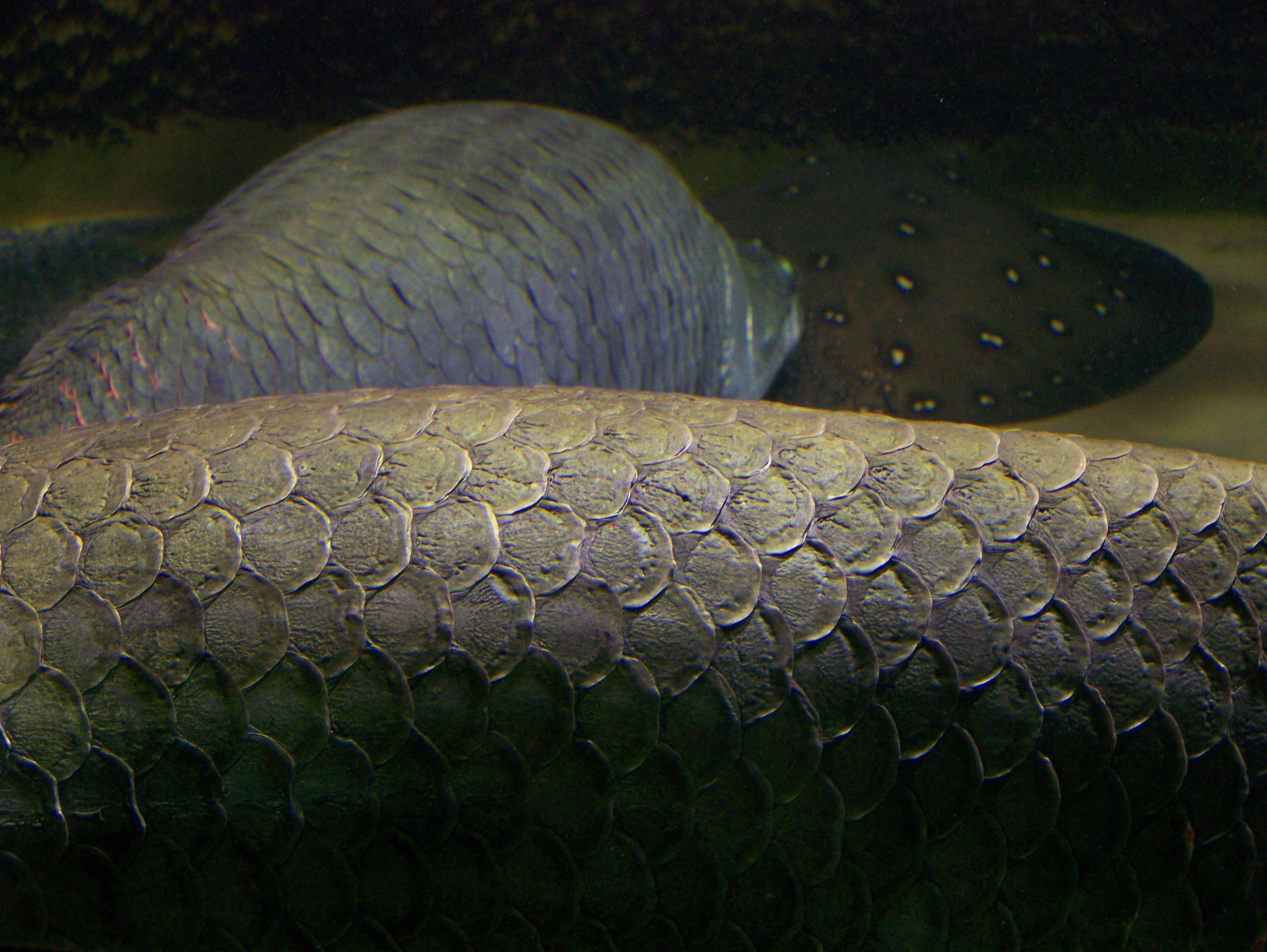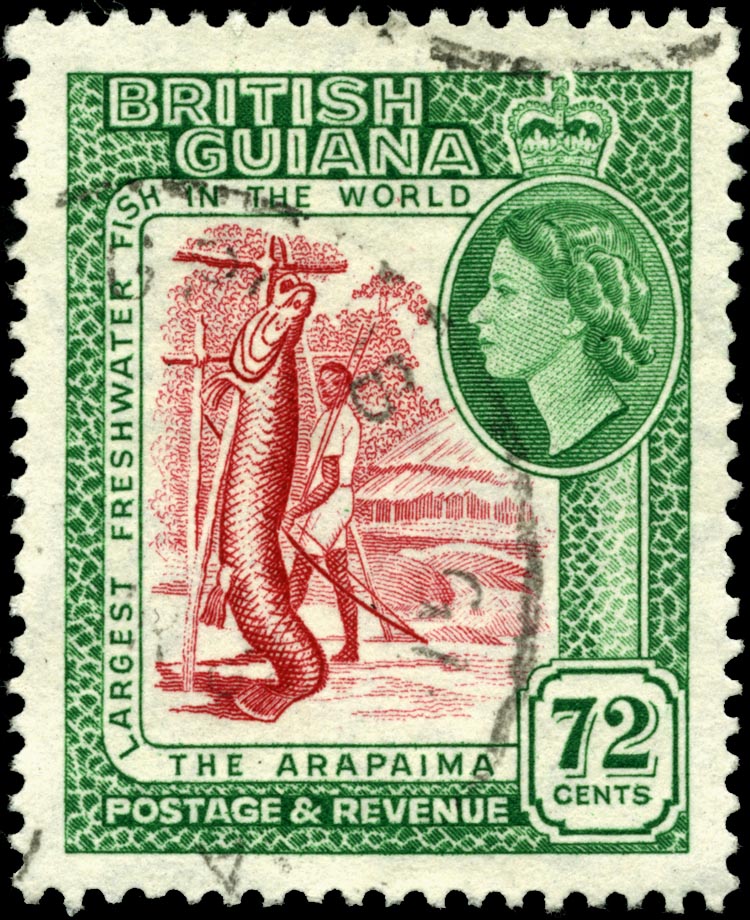|
Arapaima
The arapaima, pirarucu, or paiche is any large species of bonytongue in the genus ''Arapaima'' native to the Amazon and Essequibo basins of South America. ''Arapaima'' is the type genus of the subfamily Arapaiminae within the family Osteoglossidae.Castello, L.; and Stewart, D.J (2008). Assessing CITES non-detriment findings procedures for Arapaima in Brazil.' NDF Workshop case studies (Mexico 2008), WG 8 – Fishes, Case study 1 They are among the world's largest freshwater fish, reaching as much as in length. They are an important food fish. They have declined in the native range due to overfishing and habitat loss. In contrast, arapaima have been introduced to several tropical regions outside the native range (within South America and elsewhere), where they are sometimes considered invasive species. In Kerala, India, arapaima escaped from aquaculture ponds after floods in 2018. Its Portuguese name, ''pirarucu'', derives from the Tupi language words ''pira'' and ''urucum'', ... [...More Info...] [...Related Items...] OR: [Wikipedia] [Google] [Baidu] |
Arapaima Arapaima
The arapaima, pirarucu, or paiche is any large species of bonytongue in the genus ''Arapaima'' native to the Amazon and Essequibo basins of South America. ''Arapaima'' is the type genus of the subfamily Arapaiminae within the family Osteoglossidae.Castello, L.; and Stewart, D.J (2008). Assessing CITES non-detriment findings procedures for Arapaima in Brazil.' NDF Workshop case studies (Mexico 2008), WG 8 – Fishes, Case study 1 They are among the world's largest freshwater fish, reaching as much as in length. They are an important food fish. They have declined in the native range due to overfishing and habitat loss. In contrast, arapaima have been introduced to several tropical regions outside the native range (within South America and elsewhere), where they are sometimes considered invasive species. In Kerala, India, arapaima escaped from aquaculture ponds after floods in 2018. Its Portuguese name, ''pirarucu'', derives from the Tupi language words ''pira'' and ''urucum'', ... [...More Info...] [...Related Items...] OR: [Wikipedia] [Google] [Baidu] |
Arapaima Gigas
''Arapaima gigas'', also known as pirarucu, is a species of arapaima native to the basin of the Amazon River. Once believed to be the sole species in the genus, it is among the largest freshwater fish. The species is an obligate air-breather, so needs to come to the surface regularly to gulp air. Taxonomy ''Arapaima gigas'' was originally regarded as the only species in the genus ''Arapaima'', but the subsequent identification of further species, together with the rarity of specimens and the loss of several type specimens, has led to some uncertainty regarding classification within the genus and the identity of described individuals. Description The species is among the largest known freshwater fish, commonly measuring and reportedly exceptionally reaching lengths of up to . Adults may weigh up to . ''A. gigas'' has a streamlined body with dorsal and anal fins set well back towards the tail. While the body is mainly gray to gray-green, its Brazilian local name ''pirarucu'' d ... [...More Info...] [...Related Items...] OR: [Wikipedia] [Google] [Baidu] |
Bonytongue
Arapaiminae is a subfamily of freshwater osteoglossiform (bony-tongued) fishes belonging to the family Osteoglossidae. It includes the South American arapaimas of the Amazon and Essequibo basins and the African arowana (''Heterotis niloticus'') from the watersheds of the Sahelo-Sudanese region, Senegal, Gambia, and parts of Eastern Africa. This subfamily is sometimes raised to the rank of family, as Arapaimidae. A commonly used synonym is Heterotidinae, but according to the ICZN, Arapaiminae has priority. Arapaimines, along with other osteoglossomorphs, are of phylogenetic and evolutionary interest due to their trans-oceanic distribution, excellent fossil record, and position as one of the oldest living teleost lineages. The type-species of the group, ''Arapaima gigas'', is an important South American food source and charismatic representative of the region. Both ''Arapaima'' and ''Heterotis'' are cultured for food in their respective countries due to their heartiness and mea ... [...More Info...] [...Related Items...] OR: [Wikipedia] [Google] [Baidu] |
Amazon Basin
The Amazon basin is the part of South America drained by the Amazon River and its tributaries. The Amazon drainage basin covers an area of about , or about 35.5 percent of the South American continent. It is located in the countries of Bolivia, Brazil, Colombia, Ecuador, Guyana, Peru, Suriname, and Venezuela. Most of the basin is covered by the Amazon rainforest, also known as Amazonia. With a area of dense tropical forest, this is the largest rainforest in the world. Geography The Amazon River begins in the Andes Mountains at the west of the basin with its main tributary the Marañón River and Apurimac River in Peru. The highest point in the watershed of the Amazon is the second biggest peak of Yerupajá at . With a length of about before it drains into the Atlantic Ocean, it is one of the two longest rivers in the world. A team of scientists has claimed that the Amazon is longer than the Nile, but debate about its exact length continues. The Amazon sys ... [...More Info...] [...Related Items...] OR: [Wikipedia] [Google] [Baidu] |
Osteoglossidae
Osteoglossidae is a family of large freshwater fish, which includes the arowanas and arapaima. The family contains two subfamilies Arapaiminae and Osteoglossinae, with a total of five living genera. Osteoglossids are basal teleosts that originated some time during the Cretaceous The Cretaceous ( ) is a geological period that lasted from about 145 to 66 million years ago (Mya). It is the third and final period of the Mesozoic Era, as well as the longest. At around 79 million years, it is the longest geological period of ..., and are placed in the actinopterygiid order Osteoglossiformes. As traditionally defined, the family includes several extant species from South America, one from Africa, one from Asia, and two from Australia. References Osteoglossidae Ray-finned fish families {{Osteoglossiformes-stub ... [...More Info...] [...Related Items...] OR: [Wikipedia] [Google] [Baidu] |
Achille Valenciennes
Achille Valenciennes (9 August 1794 – 13 April 1865) was a French zoologist. Valenciennes was born in Paris, and studied under Georges Cuvier. His study of parasitic worms in humans made an important contribution to the study of parasitology. He also carried out diverse systematic classifications, linking fossil and current species. He worked with Cuvier on the 22-volume "'' Histoire Naturelle des Poissons''" (Natural History of Fish) (1828–1848), carrying on alone after Cuvier died in 1832. In 1832, he succeeded Henri Marie Ducrotay de Blainville (1777–1850) as chair of ''Histoire naturelle des mollusques, des vers et des zoophytes'' at the Muséum national d'histoire naturelle. Early in his career, he was given the task of classifying animals described by Alexander von Humboldt (1769–1859) during his travels in the American tropics (1799 to 1803), and a lasting friendship was established between the two men. He is the binomial authority for many species of fish, s ... [...More Info...] [...Related Items...] OR: [Wikipedia] [Google] [Baidu] |
Monotypic Genus
In biology, a monotypic taxon is a taxonomic group (taxon) that contains only one immediately subordinate taxon. A monotypic species is one that does not include subspecies or smaller, infraspecific taxa. In the case of genera, the term "unispecific" or "monospecific" is sometimes preferred. In botanical nomenclature, a monotypic genus is a genus in the special case where a genus and a single species are simultaneously described. In contrast, an oligotypic taxon contains more than one but only a very few subordinate taxa. Examples Just as the term ''monotypic'' is used to describe a taxon including only one subdivision, the contained taxon can also be referred to as monotypic within the higher-level taxon, e.g. a genus monotypic within a family. Some examples of monotypic groups are: Plants * In the order Amborellales, there is only one family, Amborellaceae and there is only one genus, '' Amborella'', and in this genus there is only one species, namely ''Amborella trichopoda.' ... [...More Info...] [...Related Items...] OR: [Wikipedia] [Google] [Baidu] |
Species
In biology, a species is the basic unit of Taxonomy (biology), classification and a taxonomic rank of an organism, as well as a unit of biodiversity. A species is often defined as the largest group of organisms in which any two individuals of the appropriate sexes or mating types can reproduction, produce Fertility, fertile offspring, typically by sexual reproduction. Other ways of defining species include their karyotype, DNA sequence, morphology (biology), morphology, behaviour or ecological niche. In addition, paleontologists use the concept of the chronospecies since fossil reproduction cannot be examined. The most recent rigorous estimate for the total number of species of eukaryotes is between 8 and 8.7 million. However, only about 14% of these had been described by 2011. All species (except viruses) are given a binomial nomenclature, two-part name, a "binomial". The first part of a binomial is the genus to which the species belongs. The second part is called the specifi ... [...More Info...] [...Related Items...] OR: [Wikipedia] [Google] [Baidu] |
FishBase
FishBase is a global species database of fish species (specifically finfish). It is the largest and most extensively accessed online database on adult finfish on the web.Marine Fellow: Rainer Froese ''Pew Environment Group''. Over time it has "evolved into a dynamic and versatile ecological tool" that is widely cited in scholarly publications. FishBase provides comprehensive species data, including information on taxonomy, geographical distribution, biometrics and morphology, behaviour and habitats, e ... [...More Info...] [...Related Items...] OR: [Wikipedia] [Google] [Baidu] |
World War II
World War II or the Second World War, often abbreviated as WWII or WW2, was a world war that lasted from 1939 to 1945. It involved the World War II by country, vast majority of the world's countries—including all of the great powers—forming two opposing military alliances: the Allies of World War II, Allies and the Axis powers. World War II was a total war that directly involved more than 100 million Military personnel, personnel from more than 30 countries. The major participants in the war threw their entire economic, industrial, and scientific capabilities behind the war effort, blurring the distinction between civilian and military resources. Air warfare of World War II, Aircraft played a major role in the conflict, enabling the strategic bombing of population centres and deploying the Atomic bombings of Hiroshima and Nagasaki, only two nuclear weapons ever used in war. World War II was by far the List of wars by death toll, deadliest conflict in hu ... [...More Info...] [...Related Items...] OR: [Wikipedia] [Google] [Baidu] |






